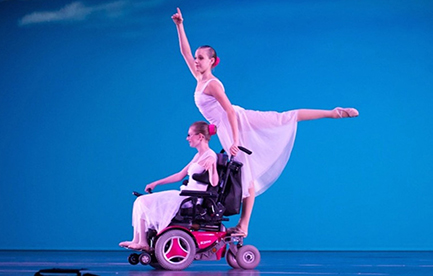
Graceful Expressions: One Young Woman is Changing Minds Through Dance
As the auditorium lights dim, the elegantly costumed dancers glide across the stage with delicate grace. At first glance, you might not notice that one of the dancers is using an electric wheelchair; that dancer is Jessica Clay. Jessica has been dancing since age 9 and although she has many other interests, dance is her true passion.
Jessica loves to dance for a number of reasons: exercise, creative self-expression; but she also sees it as an effective means of communication to induce social change and to modify perceptions about people with disabilities. Dance has been a form of expression throughout human existence. Archaeologists have found evidence of dancing dating back over 9000 years. Some believe that dance was used as a form of communication and storytelling before the invention of written languages. This long, rich tradition of dance as expressive, communicative movement carries forward to present day. Jessica sees dance as an excellent method to communicate emotion, thoughts, ideas and beauty.
After already earning three Associate of Arts degrees at Ventura College, Jessica is currently in her junior year at California State University Channel Islands. She is double majoring in Performing Arts/Dance and Political Science. “The reason I am double majoring is so I could create some much needed social change through my dance,” recalled Jessica. “I am majoring in Political Science so I could educate myself a little more on everything including social issues.”
The dance program at college that Jessica participates in is ‘integrated dance’ including dancers with and without disabilities. She regularly performs throughout southern California and has performed as far away as Texas and Washington D.C., winning a variety of awards. Jessica participates in a number of dance styles including Jazz, Modern and Lyrical dance and she enjoys them all. She has even choreographed her own dance routines. This can be especially challenging since you not only choreograph the timing and movements for the dancers but also for a 400 pound wheelchair that has its own timing. Public outreach is very important to Jessica. She has performed for a variety of fundraisers, raising money for everything from schools to cancer research, often performing in large 1500 seat theaters reaching a diverse group of people outside the dance community. Her Mom, Terri Clay, recalled “When people see her perform, they might expect something cute or stereotypical, but instead they see something really beautiful that they weren’t expecting and that is the most rewarding thing.”
Dancing as part of an integrated team is a fabulous teaching tool not just for the audience, but also for the dancers themselves. The dancers without disabilities meld their technical dance maneuvers with Jessica’s wheelchair to create a very fluid, concerted unit on stage, everything working in harmony together. The other dancers may even stand on the wheelchair during the dance, incorporating it into the routine. “This can be challenging sometimes” according to Terri “but it really promotes understanding and is a wonderful learning experience for all of the dancers.” “With integrated dance, everyone on stage is just another dancer, everyone is equal” said Jessica. “With integrated dance, there are no boundaries and no barriers.”
Breaking boundaries and barriers is a primary focus for Jessica and she feels that dance is an excellent means to that end. “I try to communicate a certain message to my audience in my dances,” recalled Jessica. Her message is that “everybody should be equal, no matter their disability or any other feature that might make them a minority.” So far, Jessica’s message has reached people. Often after performances audience members will approach her saying that they didn’t know how she could possibly dance, but after seeing her perform, they “get it.” Jessica is very open to people’s questions and does her best to try and connect with her audience. “I’m not saying that I have changed everyone’s opinion in the audience [after a show] but even if I changed one person’s perspective that would be good,” stated Jessica. “ I want to try and change people’s outlook on individuals with disabilities. Just because you are in a wheelchair, or have another disability, doesn’t mean that you can’t be a dancer or have another dream come true.”
Jessica’s future plans are to finish college and continue to use the creative arts to further her message of social justice and equality. It takes courage to go out on stage in front of an audience for all of us, perhaps even more so for people who may be differently abled. But Jessica has met that challenge head on and hopes to continue to be a voice for people with disabilities and lead by example. “Through my dance, besides creating social change, I want to show people that there are no limitations and that people can achieve anything as long as they set their minds to it.”
